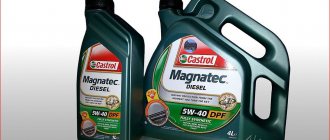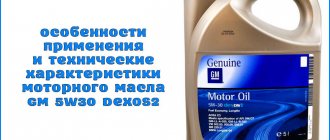What is mineral motor oil?
Mineral motor oil is a product of the distillation of fuel oil. Some types are made on the basis of industrial agricultural crops. In general, their production is simplified as much as possible, which is what makes them so cheap.
Mineral oils are effective in use, stable in action and have minimal destructive effects on parts. It is practically never used in its pure form, so approximately 10% of it consists of an additive. But the presence of an additive makes its anti-corrosion, detergent, and anti-wear properties more pronounced.
Equipment is frozen - what to do?
What advice can you give to owners of “frozen” equipment?!!
The first is to remember the law of lubrication - “The lower the temperature, the thinner the oil should be used.”
For example, if the hydraulics worked all summer at ISO 46, then for the winter it is necessary to change it to a viscosity of ISO 32, ISO 22 or even ISO 10. Motor oils with a viscosity of SAE 15W-40 are transferred to oils with a viscosity of at least SAE 10W-30, and on the eve of very severe frosts, maybe even SAE 0W-30. At the same time, keep in mind that the thinner the oil was used in cold weather, the sooner it will be changed back when warm days arrive.
For most hydraulic systems, any automatic transmission fluid (ATF) is a good multigrade oil. After all, in automatic gearboxes these fluids work both in severe frost and in extreme heat. Their approximate operating range for hydraulics will be from -30 °C (ambient air temperature) to +80 °C (oil temperature in the reservoir). Moreover, before performing work in the cold, most hydraulic systems require “warming up” by circulating hydraulic oil through the pump into the reservoir. Due to the release of heat in the pump, the oil gradually heats up and after some time becomes suitable for work. Such “starting” temperatures are even lower - down to -45 ... - 50 ° C for some hydraulic oils.
Secondly, switching to synthetic lubricants will help you survive the winter.
Synthetics have the main advantage that they are very homogeneous in chemical composition and practically do not contain paraffins, the precipitation of which from a liquid when the temperature drops thickens this liquid, or, as people say, causes “freezing”. As a rule, synthetics are much more expensive, but the gamble is worth the candle - most often, production losses are significantly higher than all costs for synthetic lubricants.
Third, try to place non-working equipment in enclosed spaces.
Even in unheated boxes the temperature is higher than in the open air. And these slightly elevated temperatures can often be decisive when starting up this equipment after an overnight stay. It is ideal for the room to be heated, at least by burning waste oil in special heaters.
Fourth, replace one oil with another as completely as possible.
Try to drain as much of the previous oil as possible, since a mixture of two oils with different viscosities may not give the desired effect.
Fifth, remember that any oil with very low freezing temperatures loses this characteristic when tiny amounts of water get into it.
Improper storage with the possibility of water ingress is the most common cause of loss of fluidity at low temperatures in most lubricants.
What is the difference between synthetics, semi-synthetics and mineral?
There are differences between mineral, semi-synthetic, and synthetic types of oils. Mineral does not respond well to changes in temperature conditions - when the temperature threshold increases, the additive begins to burn out, and when it decreases, the composition acquires a viscous consistency, which significantly reduces the performance of the mechanisms. But synthetic analogs are less responsive to temperature changes, and therefore work stably if the composition is of high quality.
A synthetic product differs from a mineral one, first of all, at the level of molecular structure. It does not require additives in such quantities, since the composition synthesizes the necessary properties even when creating the liquid. But if this type “washes” engine parts, then synthetics simply scrape off carbon deposits and deposits. High fluidity and this approach to cleaning often provokes clogging of filters and oil lines, which provokes engine failure due to lack of oil. But synthetics are still considered the best option.
Semi-synthetics are an intermediate option between synthetic and mineral. It is usually preferred in cases where the car has a high mileage, which prevents the appearance of such factors as increased carbon emissions, characteristic of synthetics. Also, semi-synthetics may be preferred in conditions where the temperature threshold does not fall below 20 degrees. But semi-synthetics will have to be changed more often.
Viscosity of transmission oils
Finally, let’s shed some light on the situation with the viscosity of transmission oils. After all, the viscosity parameter is classified by SAE for them too. Surely everyone has come across designations like 75w-90, 80w-90, 85w-140 and other options. It would seem that since the numbers are higher, then the viscosity is higher. However, in fact, their viscosity is the same as that of a motorboat, and the numbers have been changed so that these oils are not confused with each other. For example, 75w-90 gear oil has the same viscosity as 10w-40 motor oil.
At one time, VAZ even prescribed the filling of engine oil into the gearbox in the technical documentation for cars. It would be possible, of course, to leave the viscosity alone (in my opinion, to avoid confusion, the inscription on the can “transmission oil” is quite enough), but this step was taken, apparently in order to exclude the possibility of filling the transmission into the engine. If the engine, in principle, can operate satisfactorily in the box, then a reverse replacement is extremely undesirable (I would say contraindicated), since the gear oil has a much smaller supply of antioxidant, detergent and dispersant additives. There is no such high temperature in the box and no interaction with fuel combustion products, so they are simply not needed there. So in an engine, the life of the transmission will be several times less than that of engine oil.
How to replace mineral oil with synthetic oil?
There are two methods of replacing oils with synthetics from mineral water.
- To replace one remedy with another, you need to follow a certain scheme. Simply draining the old composition and pouring in a new one will not work. Initially, the “mineral water” is drained, then the oil passages are washed with car engine shampoo. Afterwards, the shampoo is drained, and synthetics are poured in.
- The second option for replacing with synthetics is to fill in mineral type oil, but of the highest quality. Next, you will need to roll up the mileage of 500-1000 km, and only then fill in synthetics. This transition is considered the most gentle for car owners and their cars.
Special types of lubricants
A large separate group includes special lubricants used in various industries.
- Slip varnishes. The material is used to create a thin lubricating film on the surface, which reduces friction and wear, and prevents moisture from entering. Varnishes can be applied both to metal surfaces and to products made of plastics and elastomers. Due to its solid state of aggregation, such a mineral lubricant is not subject to contamination during operation.
- Anti-corrosion lubricants. Materials are used to remove rust and protect metal surfaces when working in wet environments. They can be produced both in the form of mineral oils and various pastes and sprays.
- Special sealing lubricants. They are used in mechanisms (bearings, gearboxes, pneumatic drives, etc.) not only to reduce the coefficient of friction, but also as an element that reduces the impact of compressive loads.
- Lubricating pastes. The material is used to facilitate the installation connection, while providing anti-corrosion protection. There are high-temperature pastes that retain their properties up to +1200 °C.
- Lubricating waxes. They are used to create a solid oil film on the surface, which can provide protection from external environmental influences and reduce the coefficient of friction when installing parts. The wax is applied by immersion in a hot bath or as a spray emulsion.
- Release agents. Emulsions and lubricants are used in foundry and stamping to lubricate tooling. The material ensures easy removal of parts from molds and their cooling.
At what temperature does mineral oil freeze?
“Mineralka” does not tolerate low temperatures. If you live all year round in conditions where the temperature does not drop below 20 degrees, then there is no need to worry. But as the temperature drops, the oil becomes viscous. It freezes depending on its composition. But in general, the mark fluctuates between -30-40 degrees.
If you are looking for where to buy mineral oil, there are interesting offers from oil and auto chemical stores in the TAM.BY catalog.
If you notice an error in the text of the news, please highlight it and press Ctrl+Enter
Density of vegetable oils at 15°C
The density values of some vegetable and essential oils at a temperature of 15°C are presented.
The table shows the density of the following oils: orange, peanut, walnut, sesame, hazelnut and hazelnut oils, lemon, almond, sunflower and soybean oils.
The density of refined sunflower oil varies from 925 to 927 kg/m3. It should be noted that orange oil, according to the table, has a density less than sunflower oil . The average density of orange oil is 849 kg/m3.
Egg white and freezing
This option is very similar to milk cleansing. After all, during cleaning with an egg, a coagulation process occurs. The mixture reacts with harmful particles, forming sediment at the bottom of the container. So, we need 2 proteins per liter of alcohol. They need to be beaten a little (not until foam appears) and mixed with moonshine. The liquid should be filtered immediately after flakes appear. This method is quite expensive.
The easiest way to clean is by freezing. So, fusel oils freeze very easily. Place the container with the drink in the freezer. A little later you will see that part of the liquid has frozen, while the other has not changed. Leave the ice in the bottle and pour the free liquid into another container. So that you do not make a mistake, you need to mention the freezing point of alcohol. So, a drink with a strength of 9-12 degrees freezes at a temperature of minus 5 °C. But 40-degree alcohol turns into ice only at minus 30 °C.
Oil cleaning is very rarely used in moonshine. This method is designed to dissolve fusel components under the influence of vegetable oil. But alcohol and water do not react, so they remain unchanged. However, this method is quite complicated, and does not bring better results than the cleaning options described above.
Many have heard about the dangers of alcohol prepared at home compared to factory-made alcohol. This is especially true for strong alcohol, in particular moonshine. But why is moonshine so harmful? It turns out that it contains a number of impurities that are fermentation products and are very harmful to the body. In the production of vodka, a rectification process is used, resulting in a very pure drink. You can also try some simple cleaning methods at home; What is the purification of moonshine?
First of all, it is worth noting exactly what impurities affect the fact that the benefits of a homemade drink are small. These are fusel oils, aldehydes, methyl alcohol and acetone. The main purification that moonshine must undergo is distillation. It must be carried out at least twice, and at least once the “heads” and “tails” must be cut off.
What are “heads” and “tails”? During distillation, moonshine is not separated into pure fractions, as during rectification. Even though the boiling point of water is 100 degrees, some of it will boil at a lower temperature. The same applies to other parts of the mash. However, the bulk of the substance evaporates at a specific time.
When the mash temperature reaches a little more than 74 degrees, the process of evaporation of impurities, in particular acetone and methyl alcohol, begins. The moonshine that will flow into the receiving container at this time contains alcohol, but a significant part of it will be these substances. They can be easily detected by the characteristic smell of acetone. This faction is called "heads" and must be cut off.
After the “heads” another fraction is separated, called the “body”. It consists mainly of water and alcohol with small impurities. The last ones to cut off are the “tails” - a liquid with a low alcohol content and a high content of fusel oils and aldehydes. It is these oils that represent the main harmful substance in moonshine. And even though the “tails” are poured out, some part of them remains. The main methods for purifying moonshine are aimed specifically at purifying it from such oils.
Can sunflower or olive oil be stored in a glass bottle?
An excellent container for storing oil is a dark glass bottle with a tight lid , sprayer or dispenser. Another option is a ceramic container with a lid. A clear glass bottle is wrapped in foil.
Metal containers are not suitable for long-term storage. The product purchased in such a container is poured into a glass bottle.
Why you can’t buy and store vegetable oil in plastic bottles
The product is also stored in factory-made plastic bottles . The shelf life in such containers is no more than 1-3 months. For longer storage, it should be poured into a dark glass bottle. Such storage is acceptable for refined oil.
Unrefined or raw oil is poured immediately after purchase into a glass container . It is advisable to completely stop buying oil in plastic containers, because during storage, chemical compounds from plastic that are harmful to human health can transfer into the product.
Other operating parameters of mineral water
Mineral water and synthetics in cold weather
An important advantage of mineral oil for a car engine is its affordable price, but you must remember the disadvantages of the lubricant. Compliance with the rules of fluid operation will improve the operation of the internal combustion engine, extending its service life. Properly selected lubricant will protect mechanisms from corrosion and wear.
Additional characteristics of mineral engine oil include:
- Flash point is an indicator of low-boiling fractions. The volatility of the oil during operation depends on it. Low-quality fluids have a low flash point, resulting in increased lubricant consumption.
- The ability of a liquid to neutralize harmful acids and counteract deposits due to the content of active additives in the composition depends on the alkaline number.
- Pour point. This is another important parameter of mineral oil, which determines the pour point of the oil and the deterioration of its fluidity due to paraffin crystallization.
- Acid number – the content of oxidation products in the lubricant composition depends on it.
Properties [edit | edit code ]
| Sunflower oil, linoleic oil Nutritional value per 100 g of product |
| Energy value 884 kcal 3695 kJ |
| Water | |
| Squirrels | |
| Fats | 100 g |
| - saturated | 10.1 g |
| - monounsaturated | 45.4 g |
| - polyunsaturated | 40.1 g |
| Carbohydrates | |
| Retinol (vit. A ) | 0 mcg |
| Pyridoxine ( B6 ) | 0 mg |
| Folacin ( B9 ) | 0 mcg |
| Ascorbic acid (vit. C ) | 0 mg |
| Vitamin D | 0 mcg |
| Tocopherol (vit. E ) | 41.08 mg |
| Vitamin K | 5.4 mcg |
| Calcium | 0 mg |
| Iron | 0 mg |
| Magnesium | 0 mg |
| Phosphorus | 0 mg |
| Potassium | 0 mg |
| Sodium | 0 mg |
| Zinc | 0 mg |










